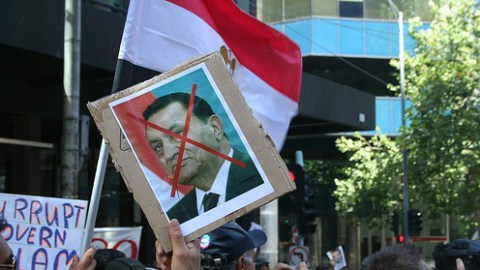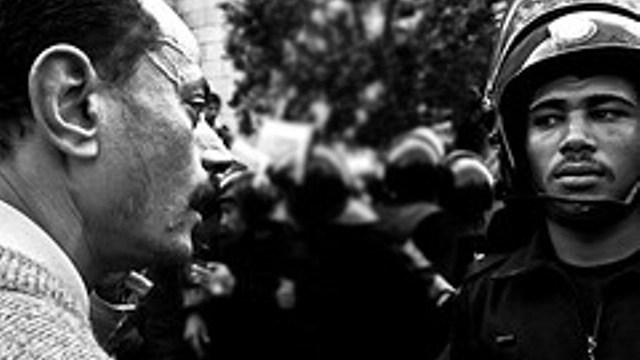The Egyptian Protests: A View from the Ground (The Beginning)

I don’t often blog about things other than Yemen, mostly because I dislike reading stuff from people who speak without knowing, and as I have been forced to listen countless international broadcasters mispronounce – Tahrir – over the past week my opinion on this has hardened.
That being said, it has been an interesting week in Cairo. What follows is not analysis or expert opinion, but my own notes from the past several days.
Thursday January 27: I arrive back home to my apartment to find the internet cut. Disappointing, but not really surprising.
Friday January 28: I spend the morning with friends celebrating a birthday, after prayers I head downtown to the Said Zaghoul stop on the Metro. This is the stop before the Sadat stop at Tahrir square. On the ride downtown we get a whiff of tear gas in the Metro car and plain clothes officers order us to shut the windows in the car. Already my eyes are burning and running and my throat is starting to hurt.
I get out at the stop and walk the two blocks to an apartment where some friends are planning on setting up a medical aid station for potential injuries. As I walk down the street, looking at building numbers, I can see a crowd at the far end squaring off in front of riot police. The crowd is big and loud.
There have been rumors of violence all morning and so I’m a bit nervous approaching the crowd. I need building 21 A, but I the buildings start at 3. The farther down the road I walk the closer I get to the protesters. One man walks the other way, turning to me and saying: “Be careful it is about to get bad.”
I keep hoping the building is behind the protesters, and it is. Just barely. Only there are two buildings labelled 21 and I need 21 A. I talk to two different guys and get two different opinions on which one is A and which one is B. The protesters seem to be warming to the chants and I want to get off the street.
I go up the stairs and ring the bell, but no one is home. Back down the stairs and away from the protesters and police, which is incredibly tense. Everyone on the street can tell it is about to blow. Walking back to the metro station I run into my friends, and back we go down the long street towards the protesters and the police. The joking and laughing stops as we see the protesters shouting at the police.
As we walk into the building police start shooting water cannons at the protesters, who seem only to get louder in defiance. We walk up the stairs to the apartment, but the key has been removed and no one knows where it is, or rather we know where it is but we can’t get it back from the doorman who took it.
Milling about in the stairwell we hear shots outside and within a few seconds the unmistakable burning of tear gas fills the stairwell. Downstairs in the lobby, people are spilling into the lobby to try to get away from the tear gas. Four flights up I hear lots of screaming and shouting and the distinctive pop of tear gas cannisters being fired into the air. Those of us with medical skills rush down to help the injured (I have none and so I help fill bottles of a mixture that helps combat the gas and guard the bags on the landing.)
For the next hour it is quite bad. The police keeping firing tear gas and people take whatever shelter they can find. The gas is getting quite bad and I keep dripping water on my t-shirt and try to breathe through it. But it is not working. Instead I pull off one t-shirt (thankfully I wore an undershirt) and wrap it around my face, but it doesn’t do much either. The gas seems trapped in the stairwell and the door at the top of the building is locked. Some of the people start to panic, but a nurse tells us not to worry that tear gas doesn’t have any long-term impact.
That helps to calm me down. My eyes are still burning and my lungs are burning, but after about 10 minutes the gas passes and it is possible to breathe again. I talk to a protester in the stairs as we take turns breathing in a mixture from a bottle that a nurse gave us.
“This isn’t about Islam,” he tells me. “Look I’m a Muslim, but all I want is a better life for me and my children.” He keeps talking and talking, almost as if the rush of the protest has to find another outlet; it is all about living with dignity.
I make my way back downstairs, the crowd is slowly starting to filter out of the building. On the street, the lines have shifted and we are now behind police lines. I see a grad student from NYU that I know and we talk for a bit before the student and a friend leave the building.
Some of the women take refuge with a family in the building while myself and a few men climb out of a broken window onto a shed and hide between the buildings as the police start to go building-to-building looking for people. We are stuck outside for nearly an hour, hoping the protests will move on. It doesn’t
One Egyptian hiding beside me tells me about being beaten the previous night. “The police arrested me, beat me, and then let me go.”
The protests still haven’t moved on. Instead one of the doormen leads police to us. They separate the Egyptians from the foreigners. The foreigners they escort out to the street and tell us to go home. The Egyptians they take away.





